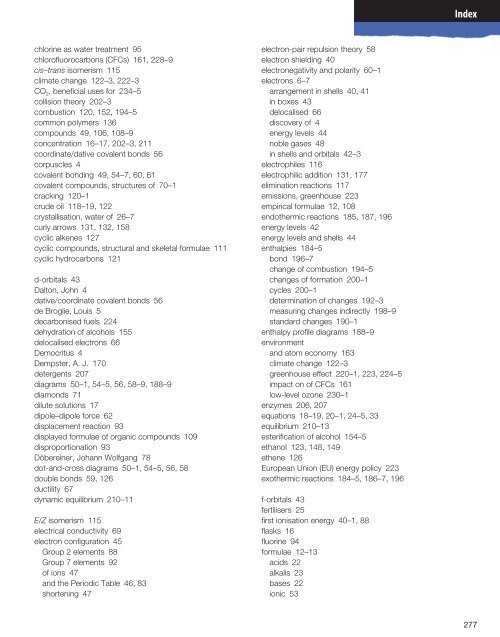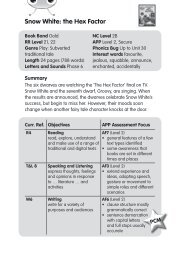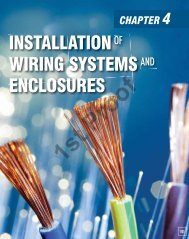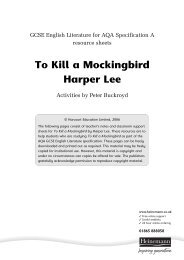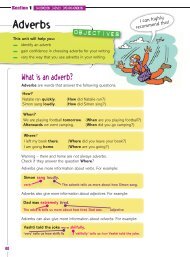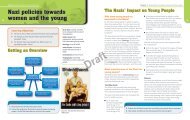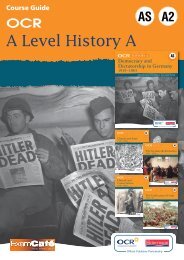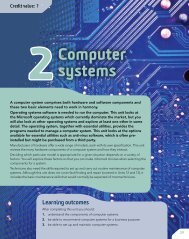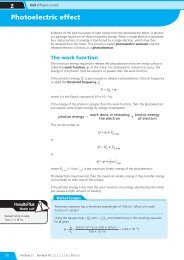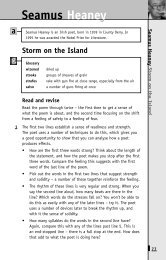Unit 1 Module 3 The Periodic Table - Pearson Schools
Unit 1 Module 3 The Periodic Table - Pearson Schools
Unit 1 Module 3 The Periodic Table - Pearson Schools
You also want an ePaper? Increase the reach of your titles
YUMPU automatically turns print PDFs into web optimized ePapers that Google loves.
Index<br />
chlorine as water treatment 95<br />
chlorofluorocarbons (CFCs) 161, 228–9<br />
cis–trans isomerism 115<br />
climate change 122–3, 222–3<br />
CO 2 , beneficial uses for 234–5<br />
collision theory 202–3<br />
combustion 120, 152, 194–5<br />
common polymers 136<br />
compounds 49, 106, 108–9<br />
concentration 16–17, 202–3, 211<br />
coordinate/dative covalent bonds 56<br />
corpuscles 4<br />
covalent bonding 49, 54–7, 60, 61<br />
covalent compounds, structures of 70–1<br />
cracking 120–1<br />
crude oil 118–19, 122<br />
crystallisation, water of 26–7<br />
curly arrows 131, 132, 158<br />
cyclic alkenes 127<br />
cyclic compounds, structural and skeletal formulae 111<br />
cyclic hydrocarbons 121<br />
d-orbitals 43<br />
Dalton, John 4<br />
dative/coordinate covalent bonds 56<br />
de Broglie, Louis 5<br />
decarbonised fuels 224<br />
dehydration of alcohols 155<br />
delocalised electrons 66<br />
Democritus 4<br />
Dempster, A. J. 170<br />
detergents 207<br />
diagrams 50–1, 54–5, 56, 58–9, 188–9<br />
diamonds 71<br />
dilute solutions 17<br />
dipole–dipole force 62<br />
displacement reaction 93<br />
displayed formulae of organic compounds 109<br />
disproportionation 93<br />
Döbereiner, Johann Wolfgang 78<br />
dot-and-cross diagrams 50–1, 54–5, 56, 58<br />
double bonds 59, 126<br />
ductility 67<br />
dynamic equilibrium 210–11<br />
E/Z isomerism 115<br />
electrical conductivity 69<br />
electron configuration 45<br />
Group 2 elements 88<br />
Group 7 elements 92<br />
of ions 47<br />
and the <strong>Periodic</strong> <strong>Table</strong> 46, 83<br />
shortening 47<br />
electron-pair repulsion theory 58<br />
electron shielding 40<br />
electronegativity and polarity 60–1<br />
electrons 6–7<br />
arrangement in shells 40, 41<br />
in boxes 43<br />
delocalised 66<br />
discovery of 4<br />
energy levels 44<br />
noble gases 48<br />
in shells and orbitals 42–3<br />
electrophiles 116<br />
electrophilic addition 131, 177<br />
elimination reactions 117<br />
emissions, greenhouse 223<br />
empirical formulae 12, 108<br />
endothermic reactions 185, 187, 196<br />
energy levels 42<br />
energy levels and shells 44<br />
enthalpies 184–5<br />
bond 196–7<br />
change of combustion 194–5<br />
changes of formation 200–1<br />
cycles 200–1<br />
determination of changes 192–3<br />
measuring changes indirectly 198–9<br />
standard changes 190–1<br />
enthalpy profile diagrams 188–9<br />
environment<br />
and atom economy 163<br />
climate change 122–3<br />
greenhouse effect 220–1, 223, 224–5<br />
impact on of CFCs 161<br />
low-level ozone 230–1<br />
enzymes 206, 207<br />
equations 18–19, 20–1, 24–5, 33<br />
equilibrium 210–13<br />
esterification of alcohol 154–5<br />
ethanol 123, 148, 149<br />
ethene 126<br />
European Union (EU) energy policy 223<br />
exothermic reactions 184–5, 186–7, 196<br />
f-orbitals 43<br />
fertilisers 25<br />
first ionisation energy 40–1, 88<br />
flasks 16<br />
fluorine 94<br />
formulae 12–13<br />
acids 22<br />
alkalis 23<br />
bases 22<br />
ionic 53<br />
277<br />
935 chemistry.endmatter.indd 277 13/11/07 1:24:40 pm


